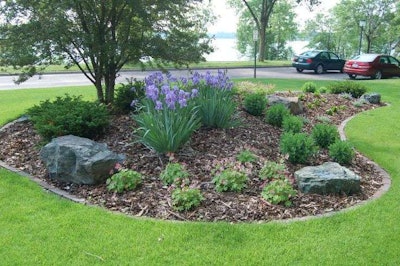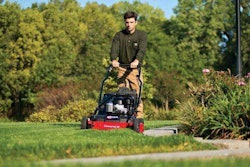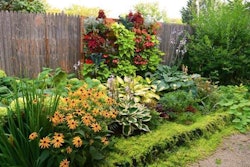
 A berm can serve as a way to redirect rainwater and be a beautiful lawn element.
A berm can serve as a way to redirect rainwater and be a beautiful lawn element.Photo: bachmanslandscaping.com
While water is being conserved in California, where years of drought have made it more precious than ever, parts of Texas are drowning in it. Maybe it’s time to remind your clients – no matter where they are – it doesn’t take an actual flood to end up with a flooded basement.
Here are a few tips to share with customers, or review with your crew, on keeping clients’ homes nice and dry:
Grading
As everyone knows, water runs downhill. By grading the landscape in a slope away from the house, most of the rainwater can be diverted.
Sometimes grading can be as simple as adding enough dirt to allow the pitch of the land to be at least ¼ inch per foot.
One method that Jake Harris, owner of Jake’s Designs in Colorado Springs, Colorado, uses is digging a dry creek and then filling it with cobblestones or river rock. By bisecting the yard, it causes water to flow around the sides of the house.
Another technique that Harris employs is installing a French drain that directs water into a gravel trench and then a pipe.
Extending drain lines
Even if your client has a sump pump, unless it’s placed far enough away from the house, it can cause problems. Suggest your client invest in a backup sump pump, especially if the existing pump runs all the time.
Make sure gutters and downspouts are actually functioning properly. Faulty downspout extensions concentrate rainwater near the house when it should be channeled 6-10 feet away from the structure.
“We like to do at least 20 feet from the house if you have the room,” Scott Michel, owner of Beechtree Landscape and Design, told AngiesList.com.
If dealing with gutters that can’t handle the high water volume, decorative rocks such as river stone will allow the rain to splash rather than form holes in the soil.
Watch where you place mulch
Although you know better than to place mulch against the siding, where the moisture can cause rot, your clients may not. Caution them to maintain a 6-inch gap between mulch and siding. And take care that mulch doesn’t end up in drainage ways, where it’s likely to plug inlet and culvert pipes.
Redirect the rainwater
When water overflows into a ditch and the ditch is no longer getting the job done, it’s time to consider using barriers to redirect the floodwaters elsewhere. Grass berms are a simple solution that also create unique elements in the landscape.
Be sure that the berm enhances the overall aesthetic and blends with the rest of the design. True, some clients may not want the challenge of mowing a grass berm, so another option is growing drought-tolerant plants for the top of the berm and moisture-loving plants at the bottom. The microclimate of the small hill will handle plenty of water and mowing won’t be an issue.









